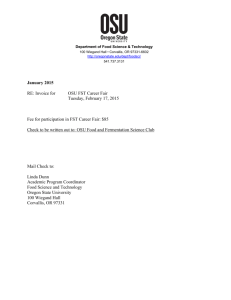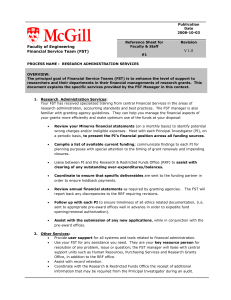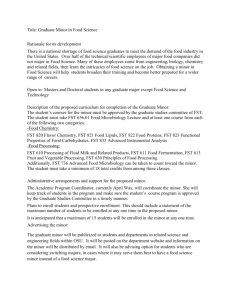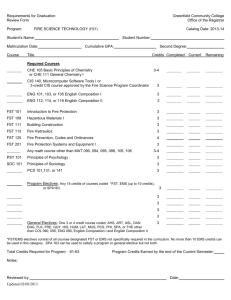Food Science and Technology
advertisement
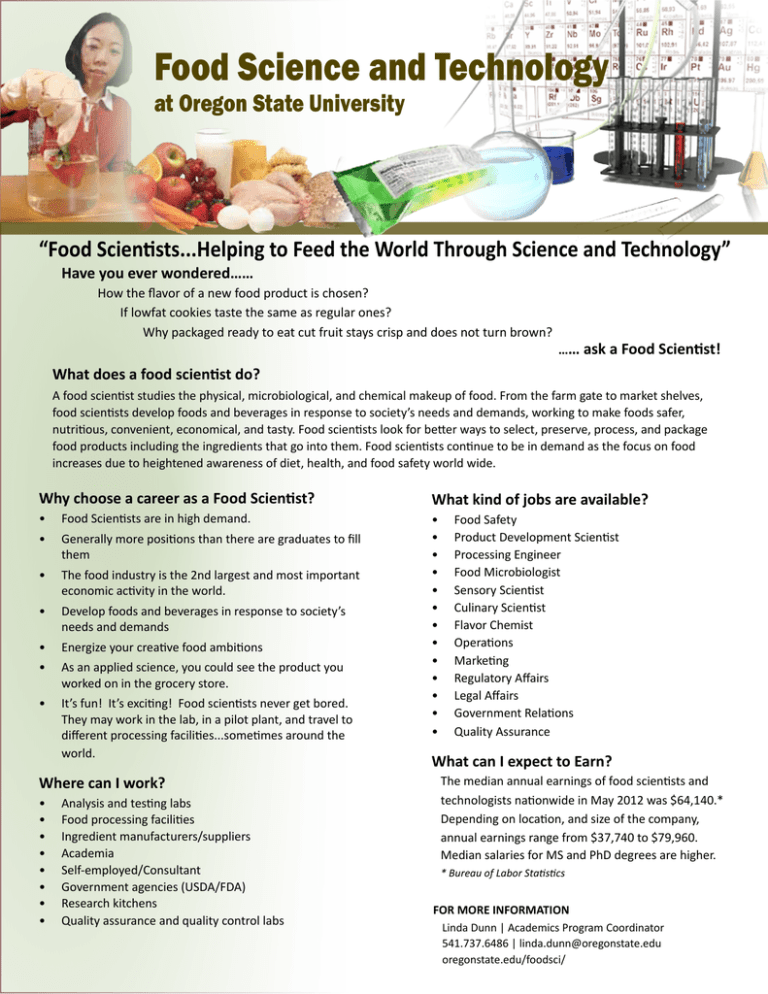
Food Science and Technology at Oregon State University “Food Scientists...Helping to Feed the World Through Science and Technology” Have you ever wondered…… How the flavor of a new food product is chosen? If lowfat cookies taste the same as regular ones? Why packaged ready to eat cut fruit stays crisp and does not turn brown? …… ask a Food Scientist! What does a food scientist do? A food scientist studies the physical, microbiological, and chemical makeup of food. From the farm gate to market shelves, food scientists develop foods and beverages in response to society’s needs and demands, working to make foods safer, nutritious, convenient, economical, and tasty. Food scientists look for better ways to select, preserve, process, and package food products including the ingredients that go into them. Food scientists continue to be in demand as the focus on food increases due to heightened awareness of diet, health, and food safety world wide. Why choose a career as a Food Scientist? What kind of jobs are available? • Food Scientists are in high demand. • • • • • • • • • • • • • • Generally more positions than there are graduates to fill them • The food industry is the 2nd largest and most important economic activity in the world. • Develop foods and beverages in response to society’s needs and demands • Energize your creative food ambitions • As an applied science, you could see the product you worked on in the grocery store. • It’s fun! It’s exciting! Food scientists never get bored. They may work in the lab, in a pilot plant, and travel to different processing facilities...sometimes around the world. Where can I work? • • • • • • • • Analysis and testing labs Food processing facilities Ingredient manufacturers/suppliers Academia Self-employed/Consultant Government agencies (USDA/FDA) Research kitchens Quality assurance and quality control labs Food Safety Product Development Scientist Processing Engineer Food Microbiologist Sensory Scientist Culinary Scientist Flavor Chemist Operations Marketing Regulatory Affairs Legal Affairs Government Relations Quality Assurance What can I expect to Earn? The median annual earnings of food scientists and technologists nationwide in May 2012 was $64,140.* Depending on location, and size of the company, annual earnings range from $37,740 to $79,960. Median salaries for MS and PhD degrees are higher. * Bureau of Labor Statistics FOR MORE INFORMATION Linda Dunn | Academics Program Coordinator 541.737.6486 | linda.dunn@oregonstate.edu oregonstate.edu/foodsci/ OSU food science graduates have been hired by... • Del Monte • Hershey’s • OR Dept. of Agriculture • Tillamook Creamery • US Food and Drug Administration • Dreyers • General Mills • Harry and David • Kettle Foods • Kraft Foods • Kroger • Pepsico • Safeway • Starbucks • TreeTop • Turtle Mountain • United States Dept. of Agriculture • And many other employers of local, national, and international prominence What do I need to study? Food Science Major Core (100-104 Cr.) Option: Food Science (con’t) Supporting Courses (71-75 Cr.) Food Science Option Required Courses (19 Cr.) Tech Wri, Science Wri, or Eng Comp WR* 327, 362, or 222 3 Sensory Evaluation of Food FST 420 4 Food Analysis FST 423 4 Public Speaking COMM 111* 3 Food Processing Calculations/Lab FST 490/491 2, 1 General Chemistry General Chemistry Lab CH* 231, 232, 233 4, 4, 4 Food Packaging FST 495 2 CH* 261, 262, 263 1, 1, 1 Food Microbiology MB 440 3 Organic Chemistry/Lab CH 331, 332/337 4, 4, 4 Fruit and Vegetable Processing FST 210 3 Quantitative Analysis CH 324 4 Dairy Processing/Lab FST 212/213 2, 1 Principles of Biology BI* 211, 212, 213 4, 4, 4 Animal Food Technology ANS 251 3 Elementary Biochemistry BB 350 4 General Microbiology/Lab MB 302/303 3, 2 Complete three credits from among FST 210, 212-213, or ANS 251. One class not used here may be applied as a Food Science Option Elective below. Select one of WR 327, 362, or 222 a Intro to Statistical Methods ST 351 4 Food Science Option Elective Courses (7 Cr.) General Physicas PH 201 5 Seminar - Leadership Academy AG 407** 3 Calculus for Mgmt & Social Science MTH 241* 4 Food Science Orientation FST 101 1 Differential Calculus MTH 251* 4 Intro. Wine, Beers and Spirits FST 251 3 Integral Calculus MTH 252 4 Food Sci & Tech in Western Culture FST 260* 3 Complete MTH 241 or MTH 251 + 252. Depending on placement, may also Wine in the Western World FST 273* 3 need to complete some part of the progression: MTH 095, 111* and 112* Research FST 401** 3 Core Food Science Courses (29 Cr.) Internship FST 410** 3 Food Safety and Sanitation FST 360 3 Innovation and Food Prod. Dev. FST 430 4 Industry Preparation/HACCP FST 370 3 Brewing Science FST 460 3 Communicating Food and Ferm Sci FST 385^ 3 Wine Production Principles FST 466 3 Senior Seminar FST 407 1 Fermentation Microbiology FST 479 3 Food Law FST 421* 3 Topics in Fermentation FST 480 1 Food Chemistry Fundamentals FST 422 4 Food Microbiology Lab MB 441 2 Food Systems Chemistry FST 425 4 Food in Non-Western Culture NUTR 216* 3 Intro to Food Engineering Principles BEE 472 5 Toxic Substances in Food TOX 429 3 Intro to Food Eng Process Design BEE 473 3 Option: Food Science (38 Cr.) Preparatory Math Additional Supporting Courses (12 Cr.) Human Nutrition Total Credits in Major NUTR 240 3 NUTR 225 may be substituted for NUTR 240 138-142 0-8 Add’l. Bacc Core 21-24 Unrestricted Electives 6-21 Minimum 180 credits required for graduation General Physics PH 202 5 Intro Statistical Methods ST 352 4 ^ Writing Intensive Course * Fulfills Bacc. Core requirements ** Competitive selection, and/or dept pre-approval required a Offered in alternate uneven years Degree requirements subject to change in accordance with OSU policies. Requests for exceptions to major requirements should be made in consultation with academic advisor to the FST Undergraduate Committee.
